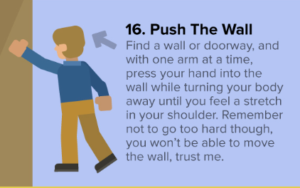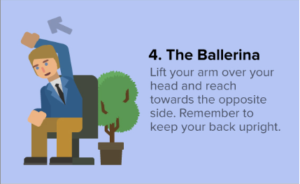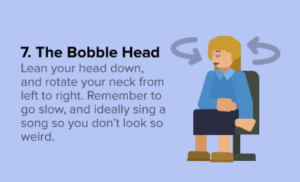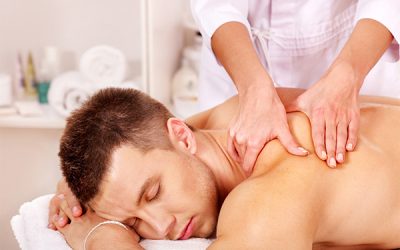Many of us look to an upcoming holiday as a chance to unwind, decompress and recharge, but sometimes the journey itself can see us arriving at our destination more fatigued than when we set out. We pry ourselves from the car or plane seat feeling achy and stale, and the first few days of the holiday are spent recovering from the journey. Sound familiar? Read on friends!
Here are some tips to help avoid these feelings, and arrive fresh and ready to holiday:
Let’s start with Luggage
Do you pack everything including the kitchen sink? Just in case? Some tips to avoid over-packing/heavy luggage:
- Write down what you think and your family will realistically need during your trip and stick to the list (they probably have a kitchen sink where you’re going!)
- Use multiple smaller bags instead of one large bag. However, if you’re limited to one bag i.e. with some airlines, pack as light as possible.
- Find travel size, miniature, light and space efficient versions of things you need
- When using a back pack, add the heaviest and flattest items towards the spine.
Lifting, pulling & pushing
Heavy lifting, bending and repetitive twisting into awkward spaces can increase potential for injury. Knowing how to handle your luggage is key to avoiding injury and strain.
Lifting
- Incorrect lifting or over-reaching for items is one of the most common causes of back pain and one of the easiest to avoid.
- Perform proper lifting techniques when you’re adding or removing your luggage from a car or the baggage carousel. Remember to use your core muscles and bend the knees to lift. To move an item, pivot with your feet.
- Keep the heavy item close to your tummy until you have set it down.
Pulling and pushing
- Switch your luggage(s) from one hand to the other so you do not have one-sided pain. This includes the push (luggage with four wheels) and pull (luggage with two wheels) suitcases.
How are you getting there?
Travelling by Car
Long journeys and prolonged sitting in the car can contribute to many muscular aches and pains. A small niggle can turn into a raging pain later.
Seat inspection
- Check the seat it has good lower back support. If your lower back feels like it’s sinking in, place an additional lumbar support or rolled towel to fill the space between your lower back and the seat.
Tune in to your tummy
- Switch your tummy muscles on. This helps minimise the strain of the low-grade vibrations from the car into your back. When you’re turning your tummy muscles on, make sure you can still breathe and talk!
Eyes to the front, people!
- Bring your shoulder blades back and down to drop the shoulders, with your eyes looking straight ahead including chin tucked back. This will help reduce the pressure on your neck.
Breaking up back-seat sibling barnies (so help me, I will turn this car around!)
- Things can get tense between siblings in a confined space for prolonged periods, but try not to turn and face the back seat too often. The bending and twisting motions can add strain to the muscles.
- Stop every 2 hours so you can all get out of the car to walk and have a stretch (and the kids can have some time apart!).
Eat up, drink up, rest up, wake up!
- Make sure you are always alert when driving. You can do this by switching the postural muscles on as mentioned above, keeping hydrated and not being hungry.
- Remember if you are ever feeling hungry, sleepy or agitated, switch drivers or pull over and take a rest.
Travelling by Plane
Long flights are notorious for causing or contributing to muscle aches and pains, usually because of the lack of movement while having to be being stationary in your seat, and being in a smaller space.
Keep moving wherever possible
- Try to stand, walk and stretch every hour. (see examples of stretches below)
H20 is your friend
- Stay hydrated. The circulated air conditioning in the cabins causes the air to be very dry and can cause dehydration. Avoid or minimise the amount of alcohol consumed.
Seat support
- Try to keep you back supported by either using a lumbar support or roll the blanket provided by the airlines to fill the gap of your lower back and seat.
- Use compression socks or stockings if you are at high risk of Deep Vein Thrombosis (DVT).
- Regularly roll your ankles and point your toes to help with circulation.
Stretch Stretch Stretch!
Here are 10 stretches for you to try during your journey. Some you can do in the comfort of your seat, and others you can do while having a break from the car, or moving around the plane.
The Ballerina
Lift your arm over your head and reach toward the opposite side. Remember to keep your back upright.
The Bobble Head
Lean your head down, and rotate your neck from left to right.
The Elbow Pump
Touch your opposite shoulder blade, and then gently grab your elbow and pull it towards the opposite side.
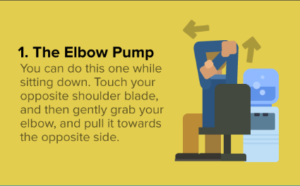
The “I don’t know”
Raise both shoulders at the same time. Hold for 5 seconds and release.
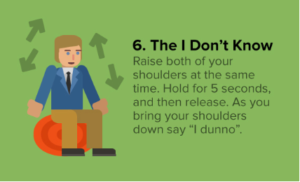
The Knee Jerk
While sitting, lift your leg up and grab onto your knee. Try to pull your leg towards your chest and see how far you can get it. Hold for 10 seconds.
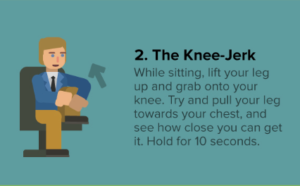
The Neck Stretcher
Take your hand and grab the opposite side of your head. Very gently pull your head towards your shoulder. No need to have your ear actually touch your shoulder, just stop when you feel a stretch.
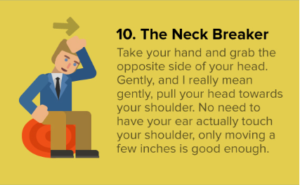
The One Armed Hug
Who doesn’t love a hug? Go on, take your left arm and grab your right shoulder. With your right hand, grab your elbow, and gently pull it towards your right shoulder. Repeat with the opposite arm. Hug it up!
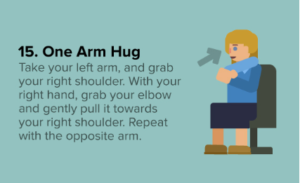
The Toe Toucher
While sitting, straighten your legs and reach out to try to touch your toes.

Touch the Sky
Interlock your hands and reach for the sky with your palms facing the ceiling. Hold for 5 seconds.
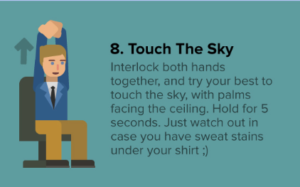
Push the Wall
Find a wall or a doorway, and with one arm at a time, press your hand into the wall, while turning your body away until you feel a stretch in your shoulder.
